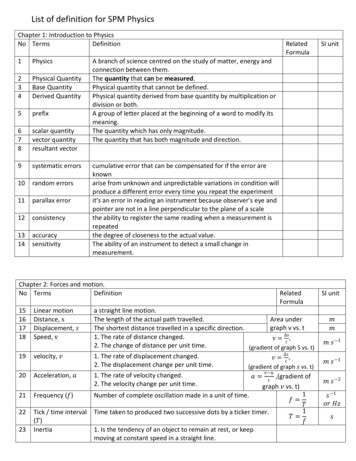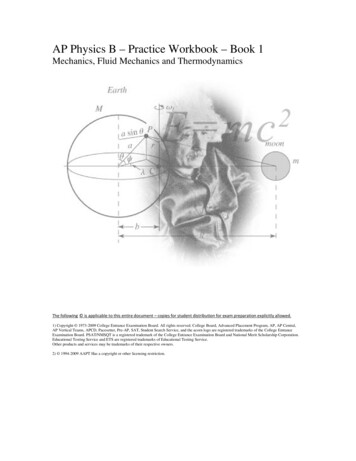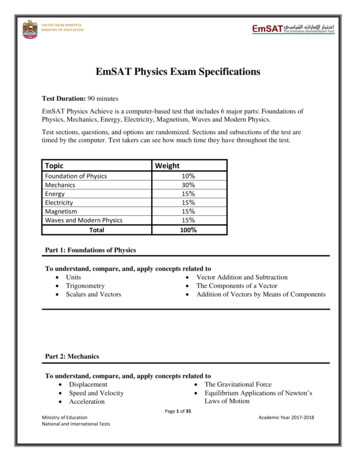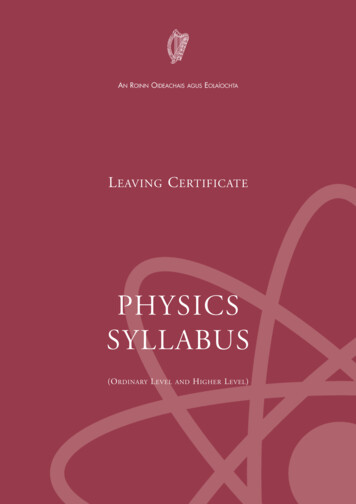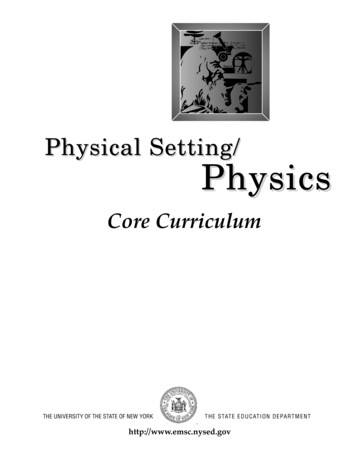
Transcription
Physical Setting/PhysicsCore CurriculumTHE UNIVERSITY OF THE STATE OF NEW YORKTHE STATE EDUCATION DEPARTMENThttp://www.emsc.nysed.gov
THE UNIVERSITY O F THE STATE O F NEW YORKRegents of The UniversityCARL T. HAYDEN, Chancellor, A.B., J.D. .ElmiraADELAIDE L. SANFORD, Vice Chancellor, B.A., M.A., P.D. .HollisDIANE O’NEILL MCGIVERN, B.S.N., M.A., Ph.D. . .Staten IslandSAUL B. COHEN, B.A., M.A., Ph.D. .New RochelleJAMES C. DAWSON, A.A., B.A., M.S., Ph.D. .PeruROBERT M. BENNETT, B.A., M.S. .TonawandaROBERT M. JOHNSON, B.S., J.D. .HuntingtonANTHONY S. BOTTAR, B.A., J.D. .NorthSyracuseMERRYL H. TISCH, B.A., M.A. .New YorkENA L. FARLEY, B.A., M.A., Ph.D. .BrockportGERALDINE D. CHAPEY, B.A., M.A., Ed.D.Belle HarborARNOLD B. GARDNER, B.A., LL.B.BuffaloCHARLOTTE K. FRANK, B.B.A., M.S.Ed., Ph.D. .New YorkHARRY PHILLIPS, 3rd, B.A., M.S.F.S. .HartsdaleJOSEPH E. BOWMAN, JR., B.A., M.L.S., M.A., M.Ed., Ed.D .AlbanyLORRAINE A. CORTÉS-VÁZQUEZ, B.A., M.P.A.BronxPresident of The University and Commissioner of EducationRICHARD P. MILLSChief Operating OfficerRICHARD H. CATEDeputy Commissioner for Elementary, Middle, Secondary, and Continuing EducationJAMES A. KADAMUSAssistant Commissioner for Curriculum, Instruction, and AssessmentROSEANNE DEFABIOAssistant Director for Curriculum and InstructionANNE SCHIANOThe State Education Department does not discriminate on the basis of age, color, religion, creed, dis ability, marital status, veteran status, national origin, race, gender, genetic predisposition or carrier sta tus, or sexual orientation in its educational programs, services, and activities. Portions of this publica tion can be made available in a variety of formats, including braille, large print or audio tape, uponrequest. Inquiries concerning this policy of nondiscrimination should be directed to the Department’sOffice for Diversity, Ethics, and Access, Room 152, Education Building, Albany, NY 12234.
CONTENTSAcknowledgments . . . . . . . . . . . . . . . . . . . . . . . . . . . . . . .viCore Curriculum . . . . . . . . . . . . . . . . . . . . . . . . . . . . . . . .1Preface . . . . . . . . . . . . . . . . . . . . . . . . . . . . . . . . . . . .3Process Skills Based on Standards 1, 2, 6, and 7 . . .6Process Skills Based on Standard 4 . . . . . . . . . . . .13Standard 4: The Physical Setting . . . . . . . . . . . . . . .14Appendices . . . . . . . . . . . . . . . . . . . . . . . . . . . . . . . . . . .19Physicsiii
ACKNOWLEDGMENTSThe State Education Department acknowledges the assistance of teachers and school administrators from acrossNew York State and the Physics Mentor Network. In particular, the State Education Department would like to thank:Joseph M. AkramoffGeorge AmannAngela Cigna-LukaszewskiBernadine Hladik CookMichael HerzogElizabeth HokansonDennis HulbertJim IakMichael JabotReuben JamesRandy JenkinsTerese KeoghRobert KruckebergWilliam LeacockEdmond NurseCarl PreskeTheodore ReissCharlene RydgrenValerie J. SuterAndrew Telesca, Jr.Virginia TrombleyButch WeirJoseph ZawickiColumbia High School, East GreenbushF. D. Roosevelt High School, Hyde ParkSyosset High School, Syosset/Hofstra UniversityJohnstown High School, JohnstownHilton Central School, HiltonNiskayuna High School, NiskayunaPlattsburgh High School, PlattsburghRush Henrietta High School, HenriettaOneida High School, OneidaSUNY Oneonta, OneontaScotia-Glenville Schools, ScotiaManhasset High School, ManhassetPhillip Randolph High School, New YorkW. C. Mepham High School, BellmoreHigh School of Transit Technology, BrooklynG. Ray Bodley High School, FultonMonroe-Woodbury High School, Central ValleyFranklin Academy High School, MaloneArlington High School, LaGrangevilleJohnson City High School, Johnson City/Binghamton UniversityAu Sable Valley High School, ClintonvilleOneonta High School, OneontaElba Central School, ElbaThe Physical Setting/Physics Core Curriculum was reviewed by many teachers and administrators across the State.The State Education Department thanks those individuals who provided feedback both formally and informally.The project manager for the development of the Physical Setting/Physics Core Curriculum was Diana K. Harding,Associate in Science Education, with content and assessment support provided by Mary Oliver, Associate inEducational Testing. Elise Russo, Associate in Science Education, provided additional support. Special thanks go toJan Christman for technical expertise and to Joe Zawicki for preliminary drafts of the document.ivPhysics
Physical Setting/PhysicsCore Curriculum
2Physics
PREFACEThis Physical Setting/Physics Core Curriculum is intended to be a catalyst for significant change in the teaching ofhigh school physics. The primary focus of the classroom experience should be on the development of higherorder process skills. The content becomes the context and the vehicle for the teaching of these skills rather thanan end in itself.This Physical Setting/Physics Core Curriculum has beenwritten to assist teachers and supervisors as they pre pare curriculum, instruction, and assessment for thephysics content and process skills of the New YorkState Learning Standards for Mathematics, Science, andTechnology. This core curriculum, including the skillssection, should be seen as part of a continuum thatelaborates the science content of Standard 4. TheLearning Standards for Mathematics, Science, andTechnology identifies key ideas and performance indica tors. This document should serve as the basis for localcurriculum development by providing insight for theinterpretation and implementation of the core under standings. Key ideas are broad, unifying, general state ments of what students need to know. The performanceindicators for each key idea are statements of what stu dents should be able to do to provide evidence thatthey understand the key idea. As part of this contin uum, this core curriculum presents major understand ings and skills that give specific detail to the conceptsunderlying each performance indicator.This core curriculum guide is not a syllabus. Itaddresses the content and process skills as applied tothe rigor and relevancy to be assessed by the in thePhysical Setting/Physics Regents Examination. Thefocus of the examination is the application of skills toreal-world situations. The core curriculum has beenprepared with the assumption that the content as out lined in the Learning Standards for Mathematics, Science,and Technology at the elementary and intermediate lev els has been taught previously. This is a guide for thepreparation of commencement-level curriculum,instruction, and assessment, the final stage in a K–12continuum of science education. Teachers should recog nize that what is found in this document (including thecore content and skills sections) is the minimum contentto be assessed. Teachers are expected to provide forhorizontal and vertical enrichment. This core curricu lum has specifically been constructed to permit theexploration of the richness of physics. Time has deliber Physicsately been built into the year to permit students toexamine these topics in greater depth or investigatenew areas of physics. This time facilitates the inclusionof experiences supporting analysis, inquiry, intercon nectedness, and problem solving. The focus on concep tual understanding in the guide is consistent with theapproaches recommended in the National ScienceEducation Standards and Benchmarks of Science Literacy:Project 2061.Misconceptions greatly influence learning. Studentsmay internalize new ideas, but if the learning is incor porated into incorrect assumptions or ideas, the learn ing is superficial and of doubtful value. Educationalresearch has shown that students typically learn best bymoving from the concrete to the abstract; learning isenhanced through the use of manipulatives and handson activities. Teachers can dramatically influence learn ing by providing constructive feedback and bymaintaining appropriately rigorous expectations.Science for All Americans: Project 2061 makes several rec ommendations that foster effective science teaching.The use of inquiry is central to scientific thought andtherefore an extremely powerful teaching tool in thephysics classroom. Real-world questions to focus theattention of the student, active student involvement,and the collection and use of evidence are essentialcomponents of effective science teaching. Since scienceis a collaborative process, the use of teams (cooperativelearning groups) is encouraged. It is important toencourage curiosity and to support academic growth,especially for female and minority students who havebeen underrepresented in physics.It is essential that instruction focus on student under standings, mathematical relationships, processes,mechanisms, and the application of concepts. Students,in attaining scientific literacy, will be able to provideexplanations in their own words, exhibiting creativeproblem solving, reasoning, and informed decision3
making. Future assessments will access students’ability to explain, analyze, and interpret physicsprocesses and phenomena and generate scienceinquiry. The general nature of the statements in thisguide will encourage the teaching of science under standing instead of emphasizing the memorization offacts. The major understandings in this guide permitteachers a large degree of flexibility, making rich andcreative instruction possible, and allowing formultifaceted assessment.The order of presentation and numbering of all state ments in this guide are not meant to indicate anyrecommended sequence of instruction. Ideas have notbeen prioritized, nor have they been organized to indi cate teaching time allotments or test weighting.Teachers are encouraged to find and elaborate for stu dents the conceptual cross-linkages that interconnectmany of the key ideas to each other and to other mathe matics, science, and technology learning standards.Historical Context:If I have seen further it is by standing on theshoulders of giants.— Sir Isaac Newton,From a letter to Robert Hooke,dated 5 February 1676.Throughout history new understandings of real-worldphenomena resulted from extensions of the work ofprevious generations. Newton’s statement reflects hisbelief that his work in mechanics and calculus wouldhave been impossible without the solid foundationestablished by both his colleagues and predecessors.All physics courses should foster an appreciation of themajor developments that significantly contributed toadvancements in the field.Greek OriginsThe foundations of physics can be traced back to theancient Greeks (600–200 BC), who sought order withinthe physical events that were understood as eitherchaotic or mystical. The idea of atoms as the fundamen tal particles of matter had a major influence over muchof the scientific investigation that occurred over thecourse of the next few centuries.The Foundations of MechanicsOn the macroscopic level, the significance of air resis tance on falling objects was established. The enuncia tion of the Three Laws of Planetary Motion appliedmathematical relationships at the planetary level. SirIsaac Newton, using this new vantage point, concludedthat a new force, gravity, was the basis for general lawsof motion as well as universal gravitation. Newton,4concurrently with Leibniz, developed calculus as a toolfor the solution of problems within physics.Subatomic InvestigationsOn a microscopic level, a relationship between electric ity and magnetism was demonstrated by the inductionof voltage in a conductor passing through a magneticfield. Electrolysis was explored; studies established aproportionality between current and the mass of a sub stance generated at an electrode. Radium was discov ered; the existence of three types of radiation—alpha,beta, and gamma rays—was demonstrated. Evidencefor both a wave nature and a quantum nature of lightwas generated during the latter half of the 19th century.The birth of quantum mechanics is fundamental tounderstanding the ability of light to exhibit bothparticle and wave characteristics.Cosmic DevelopmentsObservations at the cosmic scale continued as a redshift in the light reaching us from distant galaxies wasdiscovered; the implications of an expanding universeintrigued scientists around the world. The understand ing of gravity was refined early in the 20th centurywhen Albert Einstein introduced both special and gen eral theories of relativity. Einstein’s proposal that spaceand time are intimately and indivisibly linked fostereda spate of activity in theoretical physics.The Transistor AgeThe development of the computer is clearly a signifi cant event in the history of science. The invention oftransistors spirited in a second generation of mini-com puters and a wide range of electronic devices andapplications.The laws of physics apply from the subatomic throughthe cosmic levels, an idea whose development can betraced through the history of the science. The contribu tions of Democritus, Galileo, Kepler, Newton, Faraday,Maxwell, Planck, Curie, Hubble, Einstein, Heisenberg,Schrödinger, Feynman, Bardeen, Brattain, and Shockleyprovide insights to pivotal moments in our field. Thephysics of today is based upon the achievements of thepast. Students should appreciate the significance ofthese accomplishments and teachers should foster thisappreciation.Laboratory Requirements: The use of scientific inquiryis critical to understanding science concepts and thedevelopment of explanations of natural phenomena. Asa prerequisite for admission to the PhysicalSetting/Physics Regents Examination students musthave successfully completed a minimum of 1200 min utes of hands-on laboratory experience withPhysics
satisfactory laboratory reports on file. Due to the strongemphasis on student development of laboratory skills,a minimum of 280 minutes/week of class and labora tory time is recommended.Prior to the written portion of the Regents examination,students will be required to complete laboratory perfor mance tasks during which concepts and skills fromStandards 1, 2, 4, 6, and 7 will be assessed.The Laboratory Setting: Laboratory safety dictates thata minimum amount of space be provided for eachindividual student. According to the National ScienceTeachers Association and the American Association ofPhysics Teachers, recommended space considerationsinclude: A minimum of 60 ft2/pupil (5.6m2) which is equiv alent to 1440 ft2 (134m2) to accommodate a class of24 safely in a combination laboratory/classroom.Or,It is recommended that each school district complywith local, State, and federal codes and regulationsregarding facilities and fire and safety issues.Systems of Units: SI (International System) units areused in this core curriculum. SI units are a logicalextension of the metric system. The SI system beginswith seven fundamental units, from which all otherunits are derived. In addition to the standard funda mental and derived units of the SI system (kilogram,meter, joule, volt), other units commonly used inphysics (centimeter, kilometer) are also employed.Uncertainty of Measurements and SignificantFigures: It is an important concept in physics that allmeasurements contain some uncertainty. The reportingof such data uses significant figures to inform thereader of the uncertainty of the measurement. Whenthese values are used in calculations, it is vital thatanswers to such calculations are not misleading, andhence, rules for addition, subtraction, multiplication,and division should be followed. A minimum of 45 ft2/pupil (4.2m2) which is equiv alent to 1080 ft2 (101m2) to accommodate a class of24 safely in a stand-alone laboratory.Physics5
PROCESS SKILLSBASED ON STANDARDS 1, 2, 6, AND 7Science process skills should be based on a series of discoveries. Students learn most effectively when they have a central rolein the discovery process. To that end, Standards 1, 2, 6, and 7 incorporate in the Physical Setting/ Physics CoreCurriculum a student-centered, problem-solving approach to physics. It should be a goal of the instructor to encourage science process skills that will provide students with the background and curiosity to investigate important issues in the worldaround them.This section denotes the types and depth of the process skills the students should practice throughout the school year. Theseprocess skills are an integral part of all core-based curricula. This implies that students should already have a foundation inthese skills. The physics teacher reinforces these process skills by creating new situations for the student to investigate in thecontext of physics. During assessments, students will be presented with new situations to analyze and new problems to solveusing these process skills.In the same vein of facilitating student learning within an authentic context, students will be expected to apply the SI(International System) system of units. SI units are used in this core curriculum. The SI system begins with fundamentalunits, from which all other units are derived. In addition to the standard fundamental and derived units of the SI system(such as kilogram, meter, joule, and volt), other units such as centimeters and kilometers are commonly employed.Quantitylengthmasstimeelectric currenttemperatureamountluminous intensityFundamental bolmkgsAKmolcdNote: the use of e.g. denotes examples which may be used for in-depth study. The terms for example and such as denotematerial which is testable. Items in paranthesis denote further definition of the word(s) preceding the item and are testable.STANDARD 1Analysis, Inquiry,and DesignMATHEMATICALANALYSIS:6STANDARD 1—Analysis, Inquiry, and DesignStudents will use mathematical analysis, scientific inquiry, and engineering design, asappropriate, to pose questions, seek answers, and develop solutions.Key Idea 1:Abstraction and symbolic representation are used to communicate mathematically.M1.1 Use algebraic and geometric representations to describe and compare data. use scaled diagrams to represent and manipulate vector quantities represent physical quantities in graphical form construct graphs of real-world data (scatter plots, line or curve of best fit) manipulate equations to solve for unknowns use dimensional analysis to confirm algebraic solutionsKey Idea 2:Deductive and inductive reasoning are used to reach mathematical conclusions.M2.1 Use deductive reasoning to construct and evaluate conjectures and arguments, recog nizing that patterns and relationships in mathematics assist them in arriving at theseconjectures and arguments. interpret graphs to determine the mathematical relationship between thevariablesPhysics
STANDARD 1Analysis, Inquiry,and DesignMATHEMATICALANALYSIS:Key Idea 3:Critical thinking skills are used in the solution of mathematical problems.M3.1 Apply algebraic and geometric concepts and skills to the solution of problems. explain the physical relevance of properties of a graphical representation of realworld data, e.g., slope, intercepts, area under the curvecontinuedSTANDARD 1Analysis, Inquiry,and DesignSCIENTIFICINQUIRY:PhysicsKey Idea 1:The central purpose of scientific inquiry is to develop explanations of natural phenom ena in a continuing, creative process. develop extended visual models and mathematical formulations to represent anunderstanding of natural phenomena clarify ideas through reasoning, research, and discussion evaluate competing explanations and overcome misconceptionsKey Idea 2:Beyond the use of reasoning and consensus, scientific inquiry involves the testing ofproposed explanations involving the use of conventional techniques and proceduresand usually requiring considerable ingenuity.S2.1 Devise ways of making observations to test proposed explanations. design an experiment to investigate the relationship between physicalphenomenaS2.2 Refine research ideas through library investigations, including electronic informa tion retrieval and reviews of the literature, and through peer feedback obtainedfrom review and discussion.S2.3 Develop and present proposals including formal hypotheses to test explanations; i.e.,predict what should be observed under specific conditions if the explanation is true.S2.4 Carry out a research plan for testing explanations, including selecting and devel oping techniques, acquiring and building apparatus, and recording observationsas necessary. (Note: This could apply to many activities from simple investigations tolong-term projects.)Key Idea 3:The observations made while testing proposed explanations, when analyzed using con ventional and invented methods, provide new insights into phenomena.S3.1 Use various means of representing and organizing observations (e.g., diagrams,tables, charts, graphs, and equations) and insightfully interpret the organized data. use appropriate methods to present scientific information (e.g., lab reports,posters, research papers, or multimedia presentations) identify possible sources of error in data collection and explain their effects onexperimental resultsS3.2 Apply statistical analysis techniques when appropriate to test if chance aloneexplains the result. examine collected data to evaluate the reliability of experimental results, includ ing percent error, range, standard deviation, line of best fit, and the use of thecorrect number of significant digitsS3.3 Assess correspondence between the predicted result contained in the hypothesisand the actual result, and reach a conclusion as to whether or not the explanationon which the prediction was based is supported.S3.4 Based on the results of the test and through public discussion, revise theexplanation and contemplate additional research. (Note: Public discussion mayinclude lab partners, lab groups, classes, etc.)7
STANDARD 1Key Idea 1:Analysis, Inquiry,Engineering design is an iterative process involving modeling and optimization (findingand Designthe best solution within given constraints) which is used to develop technologicalsolutions to problems within given constraints. (Note: The design process could apply toENGINEERINGactivities from simple investigations to long-term projects.)DESIGN:T1.1 Students engage in the following steps of a design process:§ initiate and carry out a thorough investigation of an unfamiliar situa tion and identify needs and opportunities for technological invention orinnovation§ identify, locate, and use a wide range of information resources, and doc ument through notes and sketches how findings relate to the problem§ generate creative solutions, break ideas into significant functional ele ments, and explore possible refinements; predict possible outcomes,using mathematical and functional modeling techniques; choose theoptimal solution to the problem, clearly documenting ideas againstdesign criteria and constraints; and explain how human understand ings, economics, ergonomics, and environmental considerations haveinfluenced the solution§ develop work schedules and working plans which include optimal useand cost of materials, processes, time, and expertise; construct a modelof the solution, incorporating developmental modifications whileworking to a high degree of quality (craftsmanship)§ devise a test of the solution according to the design criteria and performthe test; record, portray, and logically evaluate performance test resultsthrough quantitative, graphic, and verbal means. Use a variety of cre ative verbal and graphic techniques effectively and persuasively to pre sent conclusions, predict impacts and new problems, and suggest andpursue modificationsSTANDARD 2Students will access, generate, process, and transfer information, using appropriate technologies.STANDARD 2INFORMATIONSYSTEMS:8Key Idea 1:Information technology is used to retrieve, process, and communicate information as atool to enhance learning.1.1 Understand and use the more advanced features of word processing, spreadsheets,and database software.1.2 Prepare multimedia presentations demonstrating a clear sense of audience andpurpose. (Note: Multimedia may include posters, slides, images, presentation software,etc.) extend knowledge of physical phenomena through independent investigation,e.g., literature review, electronic resources, library research use appropriate technology to gather experimental data, develop models, andpresent results1.3 Access, select, collate, and analyze information obtained from a wide range ofsources such as research databases, foundations, organizations, national libraries,and electronic communication networks, including the Internet. use knowledge of physics to evaluate articles in the popular press oncontemporary scientific topics1.4 Utilize electronic networks to share information.Physics
STANDARD 2INFORMATIONSYSTEMS:continued1.5Model solutions to a range of problems in mathematics, science, and technology,using computer simulation software. use software to model and extend classroom and laboratory experiences, recognizing the differences between the model used for understanding and realworld behaviorKey Idea 2:Knowledge of the impacts and limitations of information systems is essential to itseffective and ethical use.Key Idea 3:Information technology can have positive and negative impacts on society, dependingupon how it is used.STANDARD 6—Interconnectedness: Common ThemesStudents will understand the relationships and common themes that connect mathematics, science, and technologyand apply the themes to these and other areas of learning.Key Idea 1:Through systems thinking, people can recognize the commonalities that exist among allsystems and how parts of a system interrelate and combine to perform specificInterconnectedness:functions.Common Themes1.1 Define boundary conditions when doing systems analysis to determine whatinfluences a system and how it behaves.SYSTEMSTHINKING:STANDARD 6Key Idea 2:STANDARD 6Models are simplified representations of objects, structures, or systems used in analysis,Interconnectedness:explanation, interpretation, or design.CommonThemes2.1 Revise a model to create a more complete or improved representation of thesystem.MODELS:2.2 Collect information about the behavior of a system and use modeling tools torepresent the operation of the system. use observations of the behavior of a system to develop a model2.3 Find and use mathematical models that behave in the same manner as theprocesses under investigation. represent the behavior of real-world systems, using physical and mathematicalmodels2.4 Compare predictions to actual observations, using test models. validate or reject a model based on collated experimental data predict the behavior of a system, using a modelPhysics9
STANDARD 6Key Idea 3:Interconnectedness:The grouping of magnitudes of size, time, frequency, and pressures or other units ofCommonmeasurement into a series of relative order provides a useful way to deal with theThemesimmense range and the changes in scale that affect the behavior and design of systems.3.1 Describe the effects of changes in scale on the functioning of physical, biological, orMAGNITUDE ANDdesigned systems.SCALE:3.2 Extend their use of powers of ten notation to understanding the exponentialfunction and performing operations with exponential factors. estimate quantitative results, using orders of magnitude simplify calculations by using scientific notationSTANDARD 6Key Idea 4:Interconnectedness:Equilibrium is a state of stability due either to a lack of change (static equilibrium) or aCommonbalance between opposing forces (dynamic equilibrium).Themes4.1 Describe specific instances of how disturbances might affect a system’s equilib rium, from small disturbances that do not upset the equilibrium to largerEQUILIBRIUM ANDdisturbances (threshold level) that cause the system to become unstable.STABILITY:4.2 Cite specific examples of how dynamic equilibrium is achieved by equality ofchange in opposing directions.STANDARD 6Key Idea 5:Interconnectedness:Identifying patterns of change is necessary for making predictions about futureCommonbehavior and conditions.Themes5.1 Use sophisticated mathematical models, such as graphs and equations of variousalgebraic or trigonometric functions.PATTERNS OF predict the behavior of physical systems, using mathematical models such asCHANGE:graphs and equations5.2 Search for multiple trends when analyzing data for patterns, and identify data thatdo not fit the trends. deduce patterns from the organization and presentation of data identify and develop models, using patterns in dataKey Idea 6:STANDARD 6In order to arrive at the best solution that meets criteria within constraints, it is oftenInterconnectedness:necessary to make trade-offs.Commo
PREFACE This Physical Setting/Physics Core Curriculum is intended to be a catalyst for significant change in the teaching of high school physics. The primary focus of the classroom experience should be on the development of higher order process skills. The content becomes the context and



